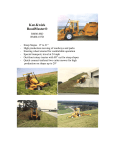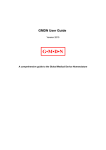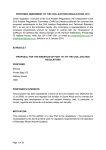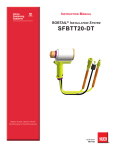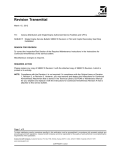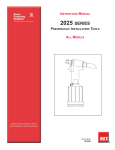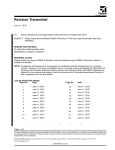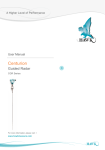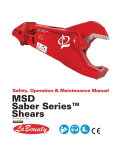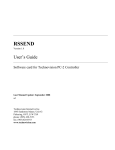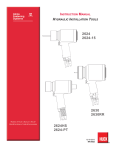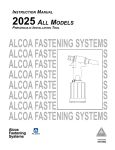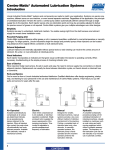Download 0806
Transcript
Form Number: CA 12-12b Accident and Incident Investigation Division Section/division AIRCRAFT SERIOUS INCIDENT REPORT AND EXECUTIVE SUMMARY Reference: Aircraft Registration Type of Aircraft ZS-PMY 10/09/2010 Date of Incident Cessna 172RG (Aeroplane) Time of Incident Commercial Pilot-in-command Flying Experience Total Flying Hours Age 1245Z Private Type of Operation Pilot-in-command Licence Type CA18/3/2/0806 19 246,2 Last point of departure Cape Town International Aerodrome (FACT) Next point of intended landing Cape Town International Aerodrome (FACT) Licence Valid Yes Hours on Type 35,3 Location of the incident site with reference to easily defined geographical points (GPS readings if possible) Cape Town International Aerodrome, Taxiway Charlie Meteorological Information Surface wind 135°/15 kt, temperature 17 °C, visibility +10 km Number of people on board 1+2 No. of people injured 0 No. of people killed 0 Synopsis The pilot, accompanied by two passengers, departed from Cape Town International Aerodrome on a local private flight. After being airborne for approximately one hour and forty-five minutes they returned to FACT for the landing. Prior to landing the pilot selected the landing gear down and normal operation was confirmed by the green ‘gear down’ light illuminating. After approximately 30 m the nose landing gear had touched down, the pilot noticed that the propeller made contact with the runway surface several times. He immediately applied back pressure to the control column to raise the nose of the aircraft. Following this intervention, the nose wheel touched down for a second time without any further problem, and the aircraft continued to roll down the runway. However, as the pilot turned right onto taxiway Charlie in order to vacate runway 19, the nose landing gear collapsed and the propeller struck the asphalt surface. The aircraft came to rest in a nose-down attitude, whereafter the pilot secured the aircraft and the three occupants disembarked from the aircraft unassisted. Probable Cause The nose landing gear (NLG) collapsed during taxiing due to the failure of one of the NLG actuator down lock pins during operation. IARC Date CA 12-12b Release Date 25 MAY 2010 Page 1 of 25 Section/division Accident and Incident Investigations Division Form Number: CA 12-12b AIRCRAFT SERIOUS INCIDENT REPORT Name of Owner/Operator : The Cape Flying Partnership Manufacturer : Cessna Aircraft Company Model : 172RG Nationality : South African Registration Marks : ZS-PMY Place : Cape Town International Aerodrome Date : 10 September 2010 Time : 1245Z All times given in this report are Co-ordinated Universal Time (UTC) and will be denoted by (Z). South African Standard Time is UTC plus 2 hours. Purpose of the Investigation: In terms of Regulation 12.03.1 of the Civil Aviation Regulations (1997) this report was compiled in the interest of the promotion of aviation safety and the reduction of the risk of aviation accidents or incidents and not to establish legal liability. Disclaimer: This report is produced without prejudice to the rights of the CAA, which are reserved. 1. FACTUAL INFORMATION 1.1 History of flight 1.1.1 The pilot, accompanied by two passengers, departed from Cape Town International aerodrome (FACT) at 1045Z on a local private flight. After being airborne for approximately one hour and forty-five minutes they returned to FACT for the landing. CA 12-12b 25 MAY 2010 Page 2 of 25 1.1.2 The prevailing wind at the time being from the south-east, the pilot was cleared to land on runway 19 by air traffic control (ATC). Prior to landing the pilot selected the landing gear down and normal operation was confirmed by the green ‘gear down’ light coming on in the cockpit. The pilot indicated that he touched down on the main landing gear and kept the nose landing gear off the ground until elevator effectiveness was lost. Approximately 30 metres after the nose wheel had touched down, the pilot noticed that the nose started dropping and the propeller struck the runway surface several times. He immediately applied back pressure to the control column and managed to raise the nose of the aircraft. Once the nose wheel settled down on the runway for the second time he continued to taxi down the runway without any further problem. As they turned right onto taxiway Charlie in order to vacate runway 19, the nose landing gear collapsed and the propeller struck the asphalt surface. The pilot then proceeded to secure the aircraft. According to the pilot there was no ‘gear unsafe’ audio warning that was activated during the sequence, either while they were on the runway or as the nose landing gear collapsed during the turn. 1.1.3 Nobody on board the aircraft was injured, and the three occupants disembarked unassisted. The aircraft was recovered by aerodrome rescue and fire-fighting (ARFF) personnel as it was obstructing/blocking the runway and was taken to a nearby maintenance facility. 1.2 Injuries to persons Injuries 1.3 Pilot Crew Pass. Other Fatal - - - - Serious - - - - Minor - - - - None 1 - 2 - Damage to aircraft 1.3.1 The aircraft sustained substantial damage when the nose landing gear collapsed. CA 12-12b 25 MAY 2010 Page 3 of 25 Visible damage to the propeller 1.4 Visible damage to the nose gear doors Other damage 1.4.1 No other damage was caused. 1.5 Personnel information 1.5.1 Pilot-in-command Nationality South African Gender Male Age Licence number ***************** Licence type Commercial Licence valid Yes Type endorsed Yes Ratings Night rating Medical expiry date 30 September 2010 Restrictions None Previous accidents None 19 Flying experience Total hours CA 12-12b 246,2 Total past 90 days 49,5 Total on type past 90 days 22,9 Total on type 35,3 25 MAY 2010 Page 4 of 25 1.6 Aircraft information 1.6.1 Airframe Type Cessna 172RG Serial no. 172RG-0218 Manufacturer Cessna Aircraft Company Year of manufacture 1980 Total airframe hours (at time of incident) 4 652,10 Last MPI (hours & date) 4 645,10 Hours since last MPI 7,0 C of A (issue date) 3 September 2004 C of R (issue date) (present owner) 2 December 2004 Operating categories Standard Part 135 30 June 2010 Engine Type Lycoming O-360-F1A6 Serial no. L-27628-36A Hours since new 2 379,40 Hours since overhaul 179,40 Propeller Type McCauley 32D-34C-220B Serial No. 000385 Hours since new 1 238,50 Hours since overhaul 998,30 1.6.2 Record of previous major defects and damage sustained Date Airframe hours Brief description of defect 20/04/1982 977,9 Nose gear retracted on take-off. Firewall forward damaged. 11/10/1988 1 745,0 Damage to front section, cabin floor and l/h wing. 20/09/1991 2 231,0 Damage to front section, nose gear doors, cowl flaps. 18/05/2005 3 653,1 Nose gear failure, propeller strike. Source: Aircraft Airframe Logbook pages 4 and 5. CA 12-12b 25 MAY 2010 Page 5 of 25 The airframe logbook contains the following entry with regard to the repairs pertaining to the nose gear failure incident on 18 May 2005: “Type of maintenance performed. Propeller Strike: Following parts replaced after landing incident: 1. Fork end, Part number: 0770-0770 2. Damper, Part number: 1442114-1 3. Clamp, Part number: 2243028-1 Sheet metal repairs carried out to nose gear wheel well. Signed off by AMO No. 221 on 5 October 2005.” The propeller logbook contains the following entry in the form of a CRMA: “The propeller, McCauley 32D-34C-220B, Serial No. 000385 had been overhauled in accordance with the relevant manual No. 780630 REV 6, SPM 100-1, BOM 100-1 REV 1 and Appendix 1 of the General Maintenance Rules Pages GMR-66 & GMR-67, Section 5.1. Major Replacements: New blades, above serials (04-1950 Mc Prop) Repairs carried out: Standard Overhaul Procedures.” 1.6.3 Nose gear inspection During the maintenance inspection, which was certified on 30 June 2010, the nose landing gear of the aircraft was inspected in accordance with the aircraft manufacturer’s service schedule (see attached document below, which was extracted from the work pack). The inspection requires a detailed inspection of the nose landing gear, which include checking for main gear down lock engagement. It does not require the down lock pins to be inspected. CA 12-12b 25 MAY 2010 Page 6 of 25 1.6.4 Certificate relating to maintenance of an aircraft (CRMA) The certificate relating to maintenance of an aircraft (see attached document below) that was issued for the aircraft ZS-PMY following the last maintenance inspection prior to the accident flight reflects that the nose gear inspection was carried out as required and that no faults were found. The system operated satisfactorily (the maintenance inspection requires five fault free cycles of the landing gear). CA 12-12b 25 MAY 2010 Page 7 of 25 1.7 Meteorological information 1.7.1 Weather information was obtained from the pilot’s questionnaire and ATC. Wind direction 135° Wind speed 15 kt Visibility Temperature 17 °C Cloud cover Clear Cloud base Dew point 1.8 +10 km Clear Unknown Aids to navigation 1.8.1 The aircraft was equipped with standard navigational equipment, which was serviceable and functioning accordingly at the time of the incident. CA 12-12b 25 MAY 2010 Page 8 of 25 1.9 Communications 1.9.1 The pilot was in radio contact with Cape Town air traffic control (ATC) on the VHF frequency 118,1 MHz at the time of the incident as the aircraft was in the process of vacating runway 19. He immediately informed ATC of the occurrence once the nose landing gear collapsed. ARFF personnel responded accordingly following the activation of the crash alarm by ATC. 1.10 Aerodrome information 1.10.1 Aerodrome details CA 12-12b Aerodrome location 7 nm SE of the city of Cape Town Aerodrome co-ordinates South 33° 58’16.93” East 018° 36’15.45” Aerodrome elevation 151 feet above mean sea level (AMSL) Runway designations 01/19 16/34 Runway dimensions 3 200 x 61 m 1 701 x 46 m Runway used 19 Threshold elevation 147 feet AMSL Runway slope Downslope of - 0.03% Runway grooved No Runway surface Asphalt Approach facilities VOR, DME, NDB, runway lights, PAPIs, ILS Aerodrome status Licensed License validity 1 September 2009 to 31 August 2010 25 MAY 2010 Page 9 of 25 1.11 Flight recorders 1.11.1 The aircraft was not equipped with a flight data recorder (FDR) or a cockpit voice recorder (CVR), nor was it required by regulation to be fitted to this type of aircraft. CA 12-12b 25 MAY 2010 Page 10 of 25 1.12 Wreckage and impact information 1.12.1 Following landing on runway 19, the pilot turned right onto taxiway Charlie to vacate the runway when the nose gear collapsed and the propeller struck the asphalt surface. The aircraft came to a halt in a nose-down attitude on the taxiway. A photo of the aircraft being recovered with the nose gear retracted. 1.13 Medical and pathological information 1.13.1 Not applicable. 1.14 Fire 1.14.1 There was no pre- or post-impact fire. CA 12-12b 25 MAY 2010 Page 11 of 25 1.15 Survival aspects 1.15.1 This incident was considered survivable. All occupants on board the aircraft were properly restrained at the time by making use of the aircraft’s safety harnesses. 1.16 Tests and research 1.16.1The aircraft was recovered from the taxiway to a maintenance facility, where it was placed on jacks. The damaged nose landing gear doors were removed, and the hydraulic fluid level was confirmed to be within the normal operating limit/range. No leaks on the system were visible. The landing gear of the aircraft was subjected to detailed inspection, after which it was decided to cycle the gear. The landing gear extended normally, but the nose landing gear would not lock down into the down lock position. Nevertheless the green ‘gear down’ warning light went out. The landing gear safe light was tested and found serviceable. The audio warning system, although soft, was operational. Upon further inspection it was found that one of the NLG actuator down lock pins had shifted against the actuator shaft, preventing the locking mechanism from achieving its down lock position. On further inspection the nose landing gear down lock actuator pins were examined and one of the pins was found to have failed (see photo below) in fatigue, causing the nose landing gear not to lock down properly within the down lock hook mechanism. A view of the actuator with the down lock pins installed. A view of the failed down lock pin contained in the housing. 1.16.2 Cessna issued a Service Bulletin SEB95-20 dated December 29, 1995 with regard to the nose landing gear actuator down lock pin inspection. Maintenance records indicate that SEB95-20 was not incorporated on this aircraft. The service bulletin is attached to this report as Annexure A. CA 12-12b 25 MAY 2010 Page 12 of 25 1.17 Organisational and management information 1.17.1 This was a private flight. The aircraft was hired by the pilot from a flying club for his private use under a hire and fly agreement. 1.17.2 According to available records the aircraft maintenance organisation (AMO) that certified the last MPI prior to the accident was in possession of a valid AMO Approval certificate that was issued by the regulating authority. 1.18 Additional information 1.18.1 Landing gear system Quoted from: Cessna 172RG Service Manual General Description: “Retraction and extension of the landing gear is accomplished by a hydraulicallypowered system, integrated with electrical circuits which help control and indicate gear position. Retraction and extension of the landing gear incorporates a nose gear actuator and two main gear actuators which control the main gear struts through a sector gear arrangement. The nose gear doors are mechanically-operated. The doors are closed with the gear retracted and are open with the landing gear extended. The main gears have no doors. Hydraulic fluid is supplied to the landing gear actuating cylinders by an electrically-powered power pack assembly, located in the cabin, forward of the center console. The hydraulic reservoir is an integral part of the power pack assembly. Gear selection is accomplished manually by moving a gear selector handle, located immediately left of the center, in the switch panel. It is necessary to pull out on the gear selector to move the handle up or down. For emergency extension of the gear, the selector handle must be in the DOWN position before the hand pump will energise the system. A pressure switch is mounted on the power pack. The switch opens the electrical circuit to the pump solenoid when pressure in the system increases to approximately 1500 psi. The pressure switch will continue to hold the electrical circuit open until pressure in the system drops to approximately 1000 psi. This will occur whether the gear selector handle is in either the UP or DOWN position. During a normal cycle, landing gear extended and locked can be detected by illumination of the DOWN indicator (green) light. The nose gear squat switch, actuated by the nose gear, prevents gear retraction whenever the nose gear is compressed by the weight of the aircraft. The GEAR UNSAFE (red) light is on anytime the gear is in transit (retracted CA 12-12b 25 MAY 2010 Page 13 of 25 cycle), or whenever system pressure drops below 1000 psi with the safety (squat) switch closed. Nose Gear System: Description: The nose gear consists of a pneudraulic shock assembly, mounted in a trunnion assembly, a nose gear steering system with bungee, a shimmy dampener, nose wheel, tire and tube, hub cap, bearings, seals and a double-acting hydraulic actuator for extension and retraction. A claw-like hook on the actuator serves as a down-lock for the nose gear. Stop bolts, located in the lower aft well, prevent inadvertent nose gear collapse. Operation: The nose gear shock strut is pivoted at the firewall. Retraction and extension of the nose gear is accomplished by a double-acting hydraulic cylinder, the forward edge of which contains the nose gear down-lock. Initial action of the cylinder disengage the down-lock before retraction begins. As the strut moves into the gear well, the forward side of the nose gear fork boss contacts an actuator assembly, causing the doors to close. The nose gear is held in the UP position by hydraulic pressure”. CA 12-12b 25 MAY 2010 Page 14 of 25 1.18.2 Similar type of serious incident According to the SACAA accident database a similar type of serious incident occurred at Bloemfontein aerodrome on 28 July 2006, involving a Cessna T210K. The pilot CA 12-12b 25 MAY 2010 Page 15 of 25 indicated that he had a landing gear down indication (green light) in the cockpit, but during the landing roll the nose landing gear collapsed. The investigation found that one of the nose landing gear down lock pins had failed. What made this incident different from the one in question is that Cessna Service Bulletin SEB95-20 was incorporated on this aircraft, yet the down lock pin failed in a similar mode. 1.19 Useful or effective investigation techniques 1.19.1 None. 2. ANALYSIS 2.1 The aircraft was released for service following a detailed maintenance inspection that was certified on 30 June 2010. The inspection was conducted in accordance with the aircraft manufacturer’s maintenance schedule, which required that a detailed inspection be performed on several nose landing gear components. The maintenance schedule, however, does not require that the two down lock pins fitted to the nose landing gear actuator be inspected. Cessna Service Bulletin (SB) SEB95-20 was an option by the aircraft manufacturer to the applicable/affected aircraft owners, which indicates that the manufacturer had introduced an improvement to the original design by issuing the SB and informed all aircraft owners that failure to comply with the SB could result in the nose landing gear not locking in the down position and collapsing. By adhering to the SB, the risk of an unforeseen nose landing gear collapse could be avoided, although no guarantees could be associated with compliance with such a bulletin. The aircraft manufacturer issues an SB in the interest of safety, but has no control over the operational aspects to which such an aircraft is exposed while in service, which could include landing and taking off from licensed and unlicensed runways/landing strips/aerodromes, hard landings, excessive braking and exceeding the design envelope/limitations of the aircraft, especially owing to maximum allowable take-off and landing weight. 2.2 This incident was, however, not an isolated occurrence. According to the SACAA accident/incident database a similar type of occurrence was recorded on 28 July 2006 when the nose landing gear of a Cessna T210K collapsed during landing. The CA 12-12b 25 MAY 2010 Page 16 of 25 investigation concluded that one of the NLG actuator down lock pins had failed and as a result the nose landing gear collapsed during the landing roll. Although not the same model of aircraft the one in question, the operation of the landing gear system was the same. It was found that Cessna Service Bulletin SEB95-20 was incorporated on the Cessna T210K, yet the nose landing gear collapsed. 2.3 The down lock pins on the nose landing gear actuator are on-condition items, and if not properly inspected/maintained they might fail in operation without prior notice. Although this aircraft was subjected to a maintenance inspection shortly prior to this failure and only 7 flying hours were recorded, it is considered highly unlikely that the fatigue cracking that might have been present at the time would have been picked up by maintenance personnel, as it was not a schedule inspection requirement to inspect these pins for cracks nor to have them subjected to any form of non-destructive crack testing procedure during maintenance. The pin was found to have failed in fatigue. 2.4 Available information indicates that this aircraft was involved in four previous incidents related to the nose landing gear (tabled in paragraph 1.6.2 of this report) over the period 20 April 1982 to 18 May 2005. None of these occurrences appears on the SACAA accident/incident database, even though it would appear that the aircraft sustained substantial damage during these incidents. The aircraft had been in service for nearly five years following the last repair, with 998,30 flying hours being logged subsequently. It was, however, not possible to draw any comparison between the previous incident dated 18 May 2005 and the one in question due to limited information being available on the previous incident (contained to the logbook entry; type of maintenance performed). 3. CONCLUSION 3.1 Findings 3.1.1 The pilot was the holder of a valid commercial pilot’s licence and had the aircraft type endorsed in his logbook. 3.1.2 The pilot was the holder of a valid aviation medical certificate that was issued by an approved CAA medical examiner. 3.1.3 The aircraft was maintained in accordance with the approved maintenance schedule and was in possession of a valid certificate of airworthiness at the time of the incident. CA 12-12b 25 MAY 2010 Page 17 of 25 3.1.4 The CRMA of the aircraft was valid. 3.1.5 The aircraft had flown 7,0 hours since the last maintenance inspection was certified. 3.1.6 Cessna Service Bulletin SEB95-20 dated December 29, 1995 was not incorporated on this aircraft. 3.1.7 The flight was operated as a private flight (Part 91) under VFR rules. 3.1.8 The was an indistinct landing gear unsafe alarm prior to the nose landing gear collapse which probably could not be heard by the pilot. 3.2 Probable cause/s 3.2.1 The nose landing gear (NLG) collapsed following touchdown due to the failure of one of the NLG actuator down lock pins. 3.3 Contributory factor/s 3.3.1 Cessna Service Bulletin SEB95-20 dated December 29, 1995 was not incorporated on this aircraft; therefore the risk of this known problem was not mitigated. 4. SAFETY RECOMMENDATIONS 4.1 It is recommended that the Director of Civil Aviation in collaboration with the Airworthiness Division introduce a life limit or non destructive test procedure at regular intervals on the down lock pins to ensure that safety is not compromised and to prevent a re-occurrence of this nature. 5. APPENDICES 5.1 Annexure A (Cessna Service Bulletin SEB95-20 dated December 29, 1995) Report reviewed and amended by the Advisory Safety Panel 18 January 2011. -END- CA 12-12b 25 MAY 2010 Page 18 of 25 ANNEXURE A Cessna Service Bulletin SEB95-20: (Shortened version) Effectively Models 172RG F182RG R182 TR182 210 T210K/L/M/N/R P210N/R *NOTE: The above list of models is a basic summary of the models affected by this Service Bulletin, which basically includes all single piston engine Cessna models with retractable landing gear. Purpose Reports have been received of the nose landing gear actuator down lock pins cracking and/or failing. The pins have failed at a circumferential groove that is used to secure the pin in the actuator bearing end. To assist in preventing this condition from occurring, an inspection should be accomplished to determine the security of the down lock pins. Actuators with down lock pins that are found to be loose should have the pins replaced according to the criteria in this service bulletin. Failure to comply with this service bulletin can potentially result in the nose landing gear to not lock in the down position and possibly collapse.” Compliance is recommended. A. Initial Inspection: Should be accomplished within the next 200 hours of operation or 12 months, whichever occurs first. CA 12-12b 25 MAY 2010 Page 19 of 25 B. Repetitive Inspections: 1. After completing the initial inspection, repeat at each gear retraction check not to exceed 200 hours of operation. 2. a. After the installation of SK210-155 (or later revision), the repetitive inspection requirement of this service bulletin is no longer required. b. After the installation of a replacement actuator bearing end or actuator that was shipped from Cessna Parts Distribution after January 1, 1996, the repetitive inspection requirement of this service bulletin is no longer required as these incorporate the modified pin installation”. Accomplishment Instructions 1. Inspect Nose Landing Ger Actuator Pins: A. Jack the airplane off the ground in accordance with the airplane service manual. B. With Master Switch in the OFF position and the hydraulic pump circuit breaker disengaged, select GEAR UP on the gear handle. Turn the Master Switch to the ON position and momentarily engage hydraulic pump circuit breaker. When gear begins to retract, disengage hydraulic pump circuit breaker and place Master Switch to the OFF position. C. Disconnect all electrical power from the airplane. Attach maintenance warning tags to the battery connector and external power receptacle stating: WARNING: DO NOT CONNECT ELECTRICAL POWER – MAINTENANCE IN PROGRESS. D. Support nose wheel so pressure is off the actuator pins. E. (Refer to Figure 1, Sheet 1, Detail A). Visually inspect actuator pins while physically attempting to rotate and/or move actuator pins about all three axes in the bearing end. No movement is allowed, as pins are a press fit. NOTE: It is permissible to use locking-type needle nose pliers to check for actuator pin looseness/movement, provided serrated teeth are removed from pliers and no galling marks are transmitted to the actuator pins. F. If any looseness or movement is observed: CA 12-12b 25 MAY 2010 Page 20 of 25 (1) Install SK210-55 prior to further flight. G. If looseness or movement is not observed, repetitive inspections of the nose gear actuator pins shall be accomplished per the compliance section of this service bulletin. 2. Make an entry in the airplane logbook stating compliance with this service bulletin and method of compliance, and if applicable, when the next inspection is due. Figure 1. Down lock Actuator Pin Inspection (Sheet 1) CA 12-12b 25 MAY 2010 Page 21 of 25 Figure 1. Down lock Actuator Pin Inspection (Sheet 1of 2) CA 12-12b 25 MAY 2010 Page 22 of 25 Accomplishment Instructions 1. Remove and Disassemble Nose Gear Actuator From Airplane: A. Jack the airplane off the ground in accordance with the airplane service manual. B. With Master Switch in the OFF position and the hydraulic pump circuit breaker disengaged, select GEAR UP on the gear handle. Turn the Master Switch to the ON position and momentarily engage hydraulic pump circuit breaker. When gear begins to retract, disengage hydraulic pump circuit breaker and place Master Switch to the OFF position. C. Disconnect all electrical power from the airplane. Attach maintenance warning tags to the battery connector and external power receptacle stating: WARNING: DO NOT CONNECT ELECTRICAL POWER – MAINTENANCE IN PROGRESS. D. Disconnect and remove the nose landing gear actuator assembly from the nose landing gear (bearing end) and fuselage (aft attach end). Cap or plug lines and fittings. (Refer to airplane service manual). E. Disassemble the nose gear actuator to gain access to the bearing end. (Refer to airplane service manual). F. Drive out existing roll pins (one per side) securing lock pins and bearing end. Remove and discard the existing 1280209-1 lock pins from the bearing end. (Refer to airplane service manual). 2. Inspect Bearing End For Out of Tolerance Condition: A. Inspect the lock pin holes in the bearing end for excessive wear and or elongation. Measure the diameter of the holes with a micrometer. The maximum allowable hole diameter is 0.3760 inch. B. If either of the holes in the bearing end are out of tolerance, replace the bearing end and proceed to Step 3.I. C. If both of the holes are within tolerance, proceed to step 3. 3. Install the 1290009-2 Lock Pins: A. Insert the 1290009-3 drill tool in pin hole on one side of bearing end. (Refer to Figure 1, Sheet 2, Detail B.) CA 12-12b 25 MAY 2010 Page 23 of 25 B. Secure the drill tool to the bearing end by inserting a 5/64 inch rod (or equivalent sized drill bit) through drill toll into the existing roll pin hole. NOTE: Drill toll contains three holes. The center hole is used to guide the drill bit when boring a new hole in the bearing end. The left and right holes are used to position the tool in the bearing end. Placement of the 5/64 inch rod in the left or right hole is dependent on which side of the bearing end is being drilled. C. With drill toll in place, drill a 5/64 (0.0781 inch diameter) hole through the center line hole in the drill tool, all the way through the bearing end. Take care to drill with minimum pressure so the drill bit does not wander. (Refer to Figure 1, Sheet 2, Detail B.) D. Using the alignment groove on the 1290009-3 drill tool, place a mark on teh bearing end for aligning the pin. E. Remove the drill tool from the bearing end. F. Repeat steps 3.A. thru 3.E. on the other side of the bearing end. G. Insert the new 1290009-2 pins in the bearing end. (Refer to Figure 1, Sheet 2, Detail C.) Ensure the alignment slot in the pin matches with the alignment mark on the bearing end created in step 3.D. Press the pins in so they protrude through the inside bearing surface 0-325 inch, ±0.005 inch. This will ensure the down lock assembly does not contact the pins when the actuator is retracted. NOTE: The hole in the new pin is larger than the 5/64 inch hole drilled in step 3.C. This is to allow for slight misalignment of the pin with the hole. It may be necessary to heat the bearing end and/or cool the pins to fit them together, as they are nominally an interference fit. H. Secure the pins with MS16562-20 roll pins inserted through the newly drilled 5/64 inch hole. I. Reassemble the actuator using new o-rings. (Refer to airplane service manual.) J. Reinstall the nose landing gear actuator using retained hardware and new MS24665-134 cotter pin. (Refer to airplane service manual.) K. Rig the nose landing gear per the airplane service manual. L. Restore electrical power and cycle the gear up and down a minimum of three times to ensure landing gear has been properly rigged. 4. CA 12-12b Remove airplane from jacks and make an entry in the airplane logbook stating 25 MAY 2010 Page 24 of 25 this service kit has been installed. Figure 1. Down lock Actuator Pin Replacement (Sheet 2) CA 12-12b 25 MAY 2010 Page 25 of 25

























